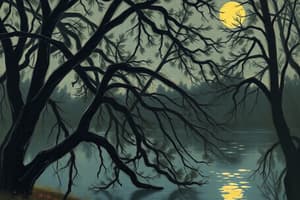Podcast
Questions and Answers
Select all the statements that describe the classical concerto. (Select all that apply)
Select all the statements that describe the classical concerto. (Select all that apply)
- The soloist always plays with the orchestra.
- The orchestra plays the main theme without the soloist.
- The classical concerto is a three-movement work for instrumental soloist and orchestra. (correct)
- The classical concerto combines the wide range of dynamics and tone colors of the orchestra with the virtuosity of the soloist. (correct)
What is a cadenza?
What is a cadenza?
An unaccompanied solo that appears in the first movement of a concerto
In a concerto, the ______ opens the first movement with the introductory exposition.
In a concerto, the ______ opens the first movement with the introductory exposition.
orchestra
Select all the statements that describe the cadenza in most classical concertos. (Select all that apply)
Select all the statements that describe the cadenza in most classical concertos. (Select all that apply)
What form does the finale of a concerto usually take?
What form does the finale of a concerto usually take?
Select all the statements describing the first movement of a classical concerto. (Select all that apply)
Select all the statements describing the first movement of a classical concerto. (Select all that apply)
Flashcards are hidden until you start studying
Study Notes
The Classical Concerto
- A classical concerto consists of three movements for a combination of instrumental soloist and orchestra.
- The format allows for interactions where the soloist may accompany the orchestra while it presents the theme.
- This musical form highlights the dynamic range and tonal colors of the orchestra alongside the soloist's virtuosity.
Cadenza
- A cadenza is an unaccompanied solo featured in the first movement of a concerto.
- Traditionally, cadenzas were improvised but later composed and written out by the composer.
- During a cadenza, the orchestra pauses, allowing the soloist to perform intricate scale passages and broken chords.
- The entrance of the cadenza is marked by a fermata, indicating a brief stop in orchestral music.
First Movement Structure
- The first movement of a classical concerto begins with the orchestra presenting the introductory exposition.
- Sonata form is utilized in the first movement, which contains two expositions: one featuring the orchestra and a second including both the soloist and orchestra.
Finale Form
- The finale of a concerto typically adopts the rondo form, providing a lively and engaging conclusion.
Studying That Suits You
Use AI to generate personalized quizzes and flashcards to suit your learning preferences.




